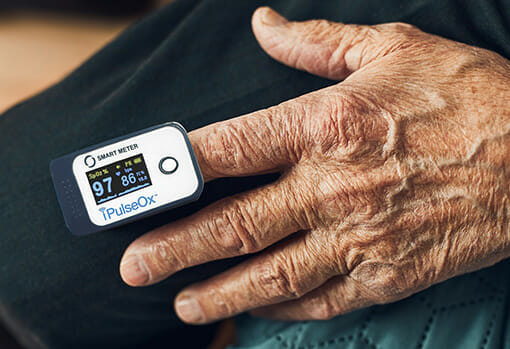Respiratory health is a fundamental aspect of our overall well-being. Proper respiratory function allows us to breathe easily, ensuring our bodies receive oxygen while expelling harmful carbon dioxide. However, many individuals face challenges maintaining optimal respiratory health because of conditions like asthma, chronic obstructive pulmonary disease (COPD), and even the lingering effects of COVID-19. Living with a respiratory condition can be difficult, with treatment often requiring constant monitoring and adjustments. The good news is Remote Patient Monitoring (RPM) has recently emerged as a game-changer in respiratory health management.
The Challenges Of Traditional Treatment For Respiratory Health Management
Traditional treatment methods for respiratory health management have long been the standard of care for individuals with conditions such as asthma and chronic obstructive pulmonary disease (COPD). While these methods have been adequate, they come with various challenges that can hinder patient well-being and overall quality of life. Historically, these challenges have included:
● Inconsistent Monitoring:
Traditional treatment typically relies on periodic visits to healthcare providers, meaning patients' respiratory health is only assessed during these appointments. This episodic approach may miss crucial changes or deterioration in lung function between visits.
● Reactive Care:
Traditional treatment tends to be reactive rather than proactive. Patients often seek medical attention only when their symptoms worsen, leading to emergency room visits or hospitalizations. This reactive approach can result in delayed interventions and poorer outcomes.
● Limited Patient Engagement:
Many patients with respiratory conditions may need to understand their condition or how to manage it effectively and clearly. Traditional treatment models often need more tools to engage patients in their care actively, leaving them feeling disempowered and less likely to adhere to treatment plans.
● Medication Compliance:
Ensuring medication adherence can be challenging in traditional treatment. Patients may forget to take their prescribed medications or be uncertain about proper inhaler technique, leading to suboptimal management of their respiratory condition.
● Time and Cost Burden:
Frequent healthcare visits, emergency room trips, and hospital stays can place a significant time and financial burden on patients. These costs extend to both the individuals managing respiratory conditions and the healthcare system as a whole.
● Limited Data for Informed Decisions:
Healthcare providers often rely on limited data collected during office visits to make treatment decisions. This lack of comprehensive, real-time data can lead to suboptimal adjustments in treatment plans.
● Environmental and Lifestyle Factors:
Traditional treatment models may not adequately address environmental factors, such as allergen exposure, smoking, or air quality, which can significantly impact respiratory health.
● Health Disparities:
Traditional treatment methods may not be equally accessible or effective for all populations, leading to health disparities in respiratory care.
Remote Patient Monitoring devices can help address these challenges. RPM devices offer continuous monitoring, real-time data collection, and personalized care plans, enabling more proactive and patient-centered approaches to respiratory health management. By leveraging technology to bridge the gaps in traditional care, RPM aims to improve the quality of life for individuals with respiratory conditions and enhance their overall well-being.
RPM & Respiratory Health
Remote patient monitoring has been particularly valuable in respiratory health management, shifting from reactive to proactive care. How are RPM devices able to do this? They continuously monitor vital respiratory parameters. Regularly monitoring respiratory metrics allows RPM to detect issues early, allowing healthcare providers to intervene before a condition worsens. Early detection can prevent unnecessary hospitalizations and improve patient outcomes.
Some of the specific ways RPM devices help improve respiratory health management include:
● Improved Inhaler Technique:
RPM can include video demonstrations or tutorials on proper inhaler techniques. This helps patients use their inhalers correctly, ensuring that the medication reaches the lungs where it's needed most.
● Lifestyle and Environmental Insights:
By tracking environmental factors like air quality, allergen exposure, and smoking habits, RPM helps individuals identify and avoid triggers that exacerbate their respiratory conditions. This empowers patients to make informed lifestyle choices that support better respiratory health.
● Enhanced Exercise and Activity Management:
RPM can monitor a patient's exercise tolerance and physical activity levels. This information allows individuals to adjust their exercise routines to optimize lung function and well-being.
● Tracking Lung Function:
RPM devices like spirometers can monitor lung function by measuring parameters like forced expiratory volume (FEV1) and forced vital capacity (FVC). This allows healthcare providers to assess the severity of conditions like asthma and COPD and make treatment adjustments accordingly.
● Monitoring Oxygen Saturation:
For individuals with respiratory conditions, maintaining adequate oxygen levels is crucial. RPM devices can continuously measure oxygen saturation levels (SpO2), alerting patients if levels fall below a certain threshold.
● Assessment of Respiratory Rate:
RPM devices can monitor respiratory rate, helping to detect abnormal or rapid breathing patterns, which may indicate respiratory distress or worsening of a condition.
● Early Detection of Sleep Apnea:
RPM can include sleep monitoring devices that detect sleep apnea episodes, allowing for timely intervention and treatment adjustments to improve sleep quality and overall respiratory health.
Improving The Quality Of Life One RPM Device At A Time
Remote Patient Monitoring is revolutionizing the way we manage respiratory health. By providing continuous, personalized care, RPM allows individuals and RPM companies to detect issues early. As technology advances, we can expect even more sophisticated RPM devices and applications to improve respiratory health management further.
As the number one supplier of Remote Patient Monitoring (RPM) solutions to a nationwide network of SmartPartners™, we know that our RPM devices help improve the quality of life for individuals with respiratory health conditions. Contact us today to learn more.




